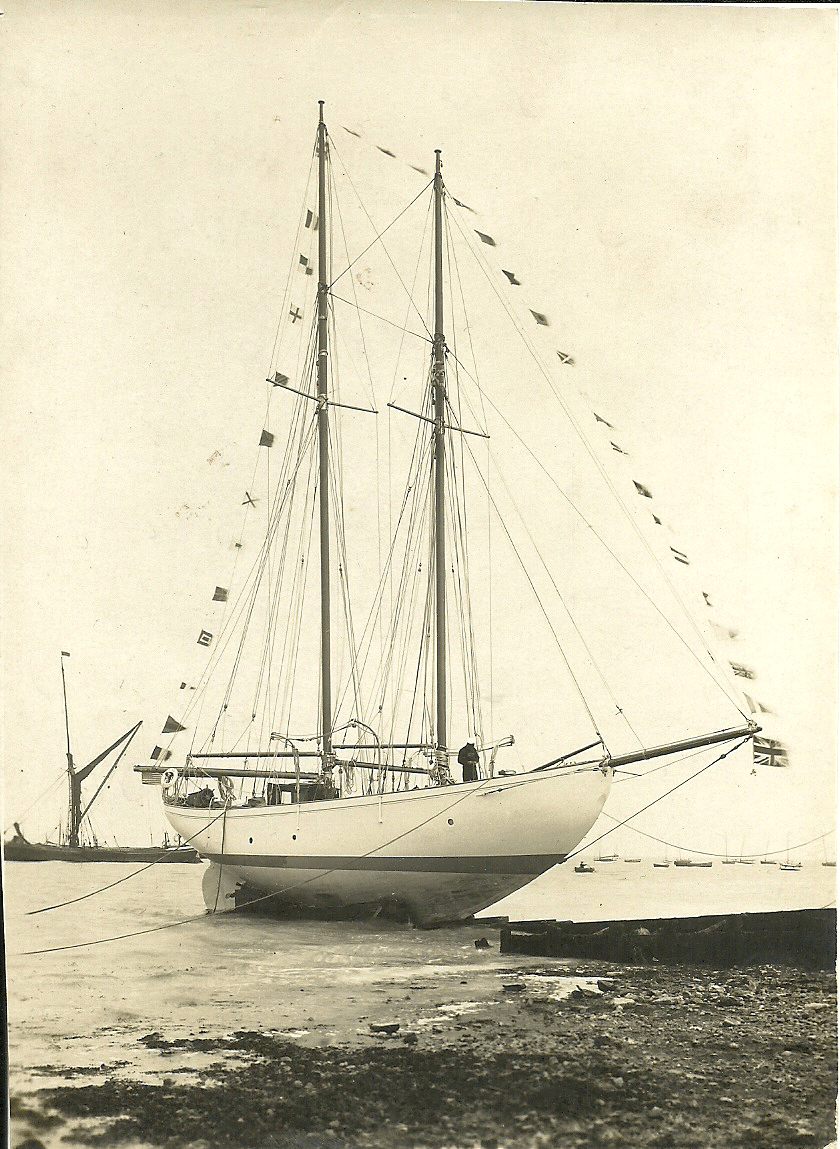Sails
To get the right look and feel with the atmosphere of yachting in the thirties, the details and panneling of the sailcloth should be as close as possible as it was in time of Carrina’s launch.
That’s why the sailmakers are strickly briefed as follows with detailed specifications for classic sailcloth:
- Narrow panels, traditional corners, hand sewn rings, external cringles, hand-roping with tapered, Rat-Tail, ends, leather finishing.
Panels for classic sails are to be narrow (15” or 18” for yacht sails)
- Boomed sails seams parallel to each other and square to the leach (cross cut)
- Panels for (boomless) headsails shall be mitre cut (diagonal cut) with the panels commencing opposite each other at the last (or diagonal) and running outward at square angles to the foot and leech of the sail
- Dacron in off white colour that duplicates the traditional Egyptian cotton (soft cream)
- Sailcloth shall be as light in weight as practical; take in account the relatively low aspect ratios of traditional boomed sails.
- Easy furling shall be an important criterion, as shall the ability to lie atop the boom when furled in a traditional, tapered cone
- Batten pockets and reef nettle reinforcements (reef patches) shall be as inconspicuous as possible
- Clew ropes should be fitted till just above the highest reef; reinforcement of the leech shall be also with small patches at the clew (the clew cringle) and at each reef cringle (cross cut Bermudian mainsail should be not provided with a tongue – diagonal headsail should have, over and next to the last or diagonal)
- Clew, tack and head ropes should be tailed
- Narrow tablings of sail material on luff (or stay tabling), leech and foot for reinforcement; for the Bermudian mainsail: mast widest tabling, then foot and the leach is the narrowest
- Reinforcing patches shall be kept small; corner reinforcing patches on Dacron should be longer to prevent crinkles coming out of point loaded corners
- UV protection: Cloth and seams/thread
Colour
Important is not to “overdo” the dyeing. A subtle cotton colour is much more desirable than one that is too yellow or has traces of green or red. In fact some bleached (former) cotton was very little difference in colour to soiled white Dacron.
Pre war sailings of Carrina
A quote from the daughter of the second owner, Mr. H.F. Blackborow (10/08/1895 – 24/09/1966):
For the moment, as H.F. Blackborow’s only surviving daughter – living in Italy – who as a little girl spent two entire summers (I think) on Carrina, I can say that my father did not race with Carrina. He almost always took the helm, but we did have a small professional crew. I can maybe fill out some information about the years between 1934 and the outbreak of war. I know my parents sailed in the Channel and the Baltic and were in Kiel harbour not long before the start of world war II. I think they also sailed as far as Casablanca and the Canaries. After the war, when Carrina came out of hiding, we sailed in the Channel from Poole in Dorset and did a lot of mackerel fishing. During a gale-force onshore wind, while we were in Portland harbour, her anchors dragged and we were almost dashed against some enormous cement constructions built in the middle of the harbour during the war for defence purposes. The naval launch that put out to help us damaged the launch and the side of the boat. As a result we were guests of the navy for several days while they put her right and spent time on board submarines, cruisers and mine sweepers!
Elizabeth Blackborow
London, the city of Carrina’s conception
London, the city and its life in which Fred. Shepherd designed and originated Carrina. Filmed in color in 1927. With a very well done comparison with London’s life in 2013.
Frederick Shepherd (1869 – 1969) had set up his 1899 own design practice in Norfolk Street, just off the Strand in central London. His business suffered during the 1914-18 war but he continued broking and designed a few yachts for clients hoping for happier times. He designed motor launches for the British Army and the Red Cross Service in France and Mesopotamia. By 1921, FS moved his design practice to the village of Swanwick on the River Hamble, only to move back to London after a couple of years to 199, Piccadilly where he would remain for the rest of his working days.
This video gives a nice comparison of city life in the days of Carrina’s conception and of the life in London these days.
our modern street life.Great news, yesterday I got a picture of the official launch of the Carrina. One I’ve never seen before. One of her former owners sent it to me.
Have a look. With great grace Carrina went down from the slipway in Whitstable. With this launch it all started. All her adventures. All the fun she donated her crew and passengers.
In a couple of weeks I’ll make a new page on the renewed site of Carrina.
In the Carib
Sail charters in the Carib, the history
Yachting in the English-speaking West Indies did not accelerate into modernity until 1947, just after World War II, when an unknown photographer and journalist named Carleton Mitchell sailed up the Lesser Antilles in a 46-foot ketch** and wrote an amazing chronicle of his trip, Islands to Windward (1947).
Chartering started in 1949 with the Nicholson’s family. With the 70 ft. schooner Mollihawk. She was the grandmother of the fleet in the early fifties and gradually joined by vessels as the 86 ft. schooner Freelance, 54 ft. schooner Carrina, 63 ft. ketch Georgiana and 70 ft. ketch Pas de Loup.They were run by European Captains, the pioneers that laid the foundation of what is the billion business of the charter industries what we have today.
I’m working on some research about the Carrina in that era. While it’s such an important activity in her past, I want to add a story about the Carrina charters on her website. So keep stayed on and in a few weeks I hope to have a nice article about her.


